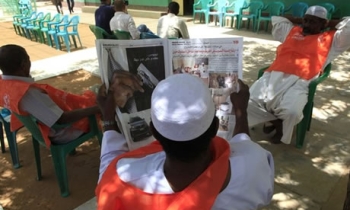Though the role of anti-tobacco advertising in reducing youth smoking has been fairly well established in recent years, a new study indicates that newspaper editorial coverage also may have a significant indirect impact.
The study evaluates the relationship between newspaper coverage of the Florida Tobacco Control Program's (FTCP) health promotion campaign with declines in youth smoking reported in statewide surveys of middle school and high school students between 1998 and 2002. Though teens rarely read newspapers, the researchers found a clear relationship between newspaper coverage and declines in youth smoking rates.
The study by researchers at RTI International has been published in the August edition of Communication Research.
"We suspect the decline in youth smoking related to newspaper coverage is the result of several factors working indirectly to influence youth behavior," said Dr Matthew Farrelly, a co-author of the study. "The most likely is that increased news coverage concerning the negative effects of youth smoking leads to changing norms about smoking behavior. In general, we believe the negative newspaper coverage creates a less-favourable or less-supportive youth smoking environment."
Launched in 1998, the Florida Tobacco Control Program included the well-known "truth" anti-smoking campaign, community-based "Students Working Against Tobacco" or SWAT groups, public relations and school-based tobacco prevention education curriculum.
In conducting the study, researchers isolated the effects of these components to measure their relative contributions to the youth smoking decline within the state.
A newspaper clipping service collected news articles published in 57 Florida daily and 199 non-daily newspapers between April 22, 1998 (immediately following the programme’s launch) and December 31, 2001, using a regularly updated set of FTCP-relevant search guidelines. The clipping service recorded the city, state, publication title, headline, date, and source publication’s self-reported circulation for each article. Articles were captured based on an exhaustive list of search guidelines provided by FTCP.
The clipping service collected a total of 2,377 articles. Three coders, blind to the project’s goals, participated in several training sessions with the study authors to refine measures and clarify content categories. After establishing reliability, coders proceeded to analyse sampled articles to identify a variety of characteristics, including the primary FTCP topic addressed in the story (SWAT or other FTCP). Articles that were inadvertently clipped were excluded, resulting in an analytic sample of 2,330 articles.
The researchers began with an examination of trends in current smoking between 1998 and 2002 by grade (MS vs HS) and cumulative newspaper coverage. They split the sample into three nearly equal groups based on cumulative newspaper coverage by county through 2002 (the end of the observation period): respondents residing in low-coverage counties, medium-coverage counties, and high-coverage counties. The researchers examined changes in current smoking between 1998 and 2002 across exposure groups and used independent samples tests to determine whether differences between groups were statistically significant in 1998 and 2002.
Smoking rates among MS students were seen to be significantly lower in 2002 than 1998
among all three groups. However, the rate of decline was larger in highcoverage counties than in low- and medium-coverage counties. Smoking rates declined from 19.8 per cent to 9.5 per cent in the high-coverage group — a 52 per cent decline.
Current smoking rates declined from 15.6 per cent to 8.4 per cent in the medium-coverage group (a 46 per cent decrease), whereas rates dropped from 21.5 per cent to 13.3 per cent in the low-coverage group (a 38 per cent decrease). Differences between the low- and high-exposure groups were not statistically significant in 1998 (difference = 1.7 percentage points) but were highly significant by 2002 (difference = 4.8 percentage points).
Trends among HS students followed a similar but more pronounced pattern than those observed among MS students. Smoking rates were significantly lower in 2002 than 1998 among all three groups, but the rate of decline was considerably larger in high-coverage counties compared to low- and medium-coverage counties. Smoking rates declined from 31.7 per cent to 19.0 per cent in the high-coverage group, a 40 per cent decline.
Current smoking rates dropped from 22.4 per cent to 15.7 per cent in the medium-coverage group (a 30 per cent decrease) and from 29.4 per cent to 23.5 per cent in the low-coverage group (a 20 per cent decrease). Differences between the low- and high-exposure groups were not statistically significant in 1998 (difference = 2.3 percentage points) but were highly significant by 2002 (difference = 4.5 percentage points.
"Perhaps the bottomline is that those contemplating a health promotion campaign should not overlook the potential value of editorial news coverage in addition to paid advertisements," said Dr Jeff Niederdeppe, lead author and researcher at the University of Wisconsin. "This study demonstrates the indirect benefits or multiplier effect that news coverage had on other campaign components."









